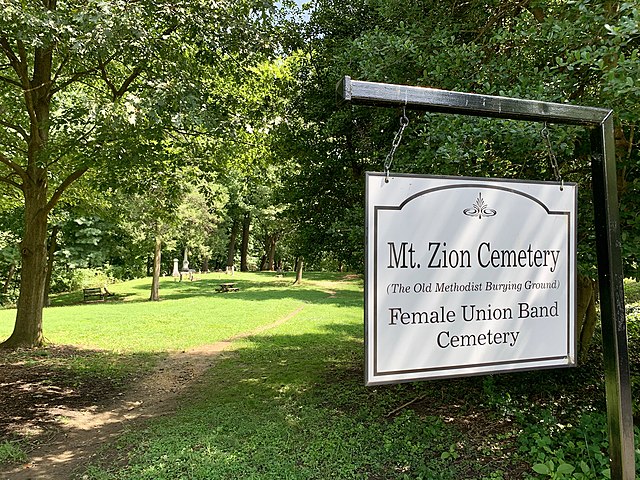
By Sam P.K. Collins, The Washington Informer, Word in Black
Over the past few decades, as Georgetown grew in prominence as one of the District’s top tourist locations, the Mount Zion-Female Union Band Society Cemetery served as a reminder of the neighborhood’s rich African American history.
That’s due, in part, to preservationists who’ve fought tooth and nail to memorialize Mount Zion-Female Union Band Society Cemetery. Such efforts have manifested in the District government’s infusion of $1.6 million for a nearby storm drainage system.
Most recently, it also inspired the D.C. Council’s commemoration of the Mount Zion-Female Union Band Society Cemetery’s 215th anniversary with the passage of a ceremonial resolution. That resolution, approved by the entire council on Feb. 6, recognizes the cemetery’s national significance as a sacred site.
This is the only cemetery for people who were born and died enslaved. Many of them had no markers.
LISA FAGER, EXECUTIVE DIRECTOR OF THE BLACK GEORGETOWN FOUNDATION
On President’s Day, community members celebrated this milestone during a tour of the Mount Zion-Female Union Band Society Cemetery led by Lisa Fager, executive director of the Black Georgetown Foundation.
“I am confident in my faith that this gesture [the D.C. Council resolution] is proof that we will no longer be neglected,” Fager said.
Since 2005, the Black Georgetown Foundation, formerly known as the Mount Zion-Female Union Band Society Historic Park Foundation, has managed the preservation and commemoration of the two cemeteries.
Responsibilities include cemetery property surveys and boundary marking, tree canopy maintenance, restoration of headstones and memorials, and genealogical research about those interred on the cemetery grounds.
During the Feb. 20 ceremony held at the cemetery, Nana Malaya Rucker-Oparabea led visitors in the pouring of libation and veneration of ancestors. Names heard emanating through the sacred grounds that morning included that of James Newton, the Black Georgetown Foundation’s late photographer, and the late D.C. Mayor Marion Barry.
Fager later highlighted President George Washington’s connection to Mount Zion-Female Union Band Society Cemetery and the burial site’s use as a stop on the Underground Railroad. In 2018, it received a designation as a United Nations Educational, Scientific and Cultural Organization (UNESCO) site of memory, in association with the “Routes of Enslaved People” project.
“We’ve been doing this for a long time,” Fager said as she went on to acknowledge the congregants of Mt. Zion United Methodist Church who were gathered at the burial site. “Today, we’re celebrating Mt. Zion Cemetery. It started in 1808, burying Blacks and whites. This is the only cemetery for people who were born and died enslaved. Many of them had no markers.”
The Cemetery’s inception dates back to 1808, when Dumbarton United Methodist Church purchased the Methodist burial ground.
Nearly a decade later, the free and enslaved Black members of Dumbarton left that church and started what was then known as Mt. Zion Methodist Episcopal Church. In 1879, Mt. Zion Methodist Episcopal Church leased the burial site from Dumbarton. In 1832, a group of free Black women started the Female Union Band Society. They later purchased a plot of land adjacent to Mt. Zion Cemetery that would also become an African American burial ground. Today, at least 8,000 people are estimated to be buried at Mt. Zion Cemetery and the Female Union Band Society Cemetery.
The history was lost and it’s found again. We have to keep telling the stories of the people buried here and maintain the land and documents.
RONALD WALTON, ORGANIST AT MT. ZION UNITED METHODIST CHURCH
Mount Zion-Female Union Band Society Cemetery counts among the oldest remaining African American cemeteries in the D.C. metropolitan area. In 1975, they were added to the District of Columbia Inventory of Historic Sites and the National Register of Historic Places.
D.C. Council member Anita Bonds (D-At large), who introduced the resolution honoring Mount Zion-Female Union Band Society Cemetery before the council earlier this month, said the District must recognize the entirety of its Black history.
“Georgetown was its own thriving subdivision before George Washington decided it would become part of one history,” Bonds said Monday at Mount Zion-Female Union Band Society Cemetery. “I want everyone to see that we have such a document [recognizing the cemetery] and that every council member signed on to it, so all of our ancestors signed on.”

Ronald Walton, an alumnus of Duke Ellington School of the Arts and organist at Mt. Zion United Methodist Church, said he gained a deep appreciation for Mount Zion-Female Union Band Society Cemetery since learning about the people buried there.
For nearly a year, Walton has been working with the Alliance of New Music-Theatre to produce an opera about Mount Zion-Female Union Band Society Cemetery that he’s scheduled to perform later this year. Such an experience introduced him to the stories of Gracey Duckett, an enslaved woman who worked at the Dumbarton House.
Walton also recounted learning about Female Union Band Society member Mary Burell and the Rev. Joseph Cartwright, one of the first preachers at Mt. Zion Methodist Episcopal Church. He said such stories have inspired him to assist the Black Georgetown Foundation in its efforts to preserve history.
“We have to show up for the cause and do the work. We have to act to save the ground,” Walton said. “The history was lost, and it’s found again. We have to keep telling the stories of the people buried here and maintain the land and documents. We must even share the story of the real Georgetown and the stories of the 227 people who were enslaved.”
_____
The post D.C. Council Recognizes Black History Site in Georgetown appeared first on The Washington Informer.


